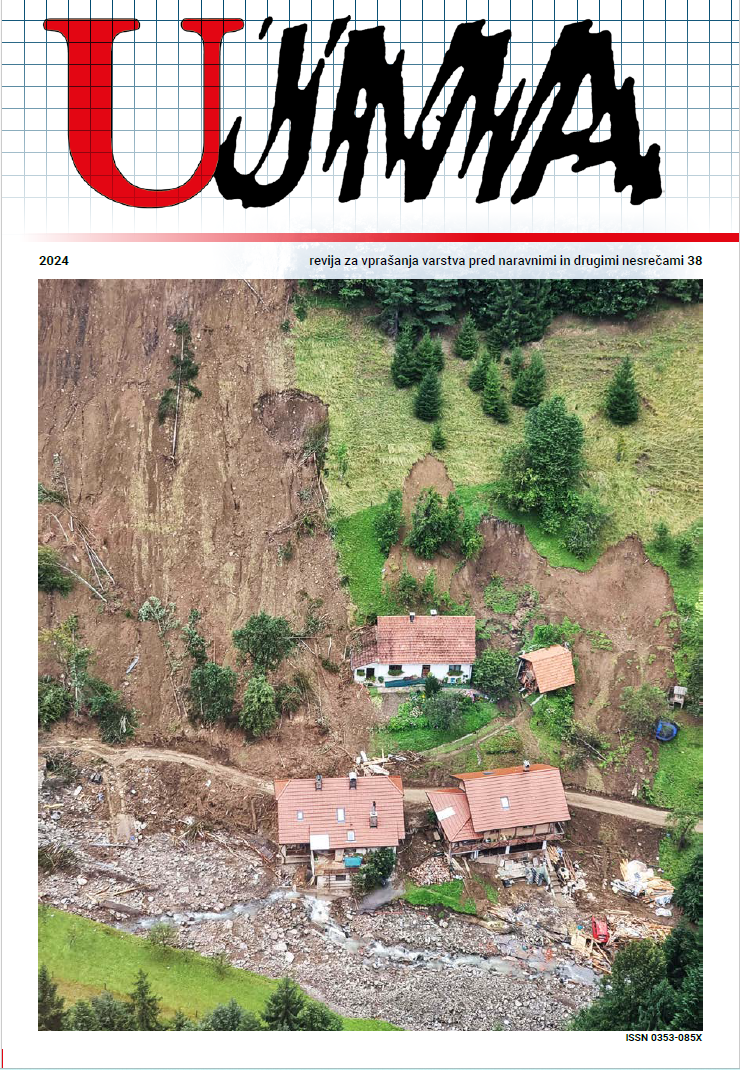CLIMATIC CONDITIONS IN SLOVENIA IN 2023
Abstract
At the national level, the average temperature in 2023 was 1.3°C above the 1991-2020 average and the highest on record. Most months were warmer than average, with January, September, October, and December having an anomaly exceeding 2°C; October and December were also the warmest on record. April stood out as cold, 1.4°C cooler than normal, while May was slightly cooler than normal. 2023 ranks as the third wettest year since the middle of the last century, with 28% more precipitation than the 1991-2020 average. Summer rainfall was 63% higher than normal, with July and August notable for their heavy monthly rainfall. The latter in particular will be remembered for the heavy rainfall on 3 August, which caused catastrophic flooding, compounded by previous waterlogging of the soil. The winter and spring were also wetter than average. Sunny weather was one percentage point above the 1991-2020 average. Solar insolation was noticeably lower than normal in January, April, and May, but well above normal in February, September, November, and December. The anomaly was smaller in June and October. In the high mountains, on Kredarica, snow cover was present for 249 days, reaching 445 cm on 18 May, and then melting before the end of June.
References
Agencija RS za okolje, 2024. Opis opazovalnih postaj. https://meteo.arso.gov.si/met/sl/climate/observation-stations/description/, 23. 5. 2024.
Agencija RS za okolje, Arhiv meteoroloških podatkov Agencije RS za okolje. http://meteo.arso.gov.si/met/sl/archive/, 10. 5. 2024.
Agencija RS za okolje, 2023. Mesečni bilten Agencije RS za okolje Naše okolje, 1–12. https://www.arso.gov.si/odstotkov20agenciji/knjižnica/mesečni%20bilten/bilten2023.htm, 10. 5. 2024.
Agencija RS za okolje, 2019. https://meteo.arso.gov.si/uploads/probase/www/climate/text/sl/publications/OPS21_povzetek_posodobljeno.pdf, 15. 5. 2024.
Bertalanič, R., 2023. Prehod na novo podnebno primerjalno obdobje 1991–2020, Naše okolje, 1, 3–10.
Cegnar, T., 2014. Podnebne razmere v Sloveniji leta 2013, Ujma, 28, 20–30.
Cegnar, T., 2015. Podnebne razmere v Sloveniji leta 2014, Ujma, 29, 22–34.
Cegnar, T., 2016. Podnebne razmere v Sloveniji leta 2015, Ujma, 30, 18–29.
Cegnar, T., 2017. Podnebne razmere v Sloveniji leta 2016, Ujma, 31, 16–28.
Cegnar, T., 2018. Podnebne razmere v Sloveniji leta 2017, Ujma, 32, 22–36.
Cegnar, T., 2019. Podnebne razmere v Sloveniji leta 2018, Ujma, 33, 24–39.
Cegnar, T., 2021. Podnebne razmere v Sloveniji v letih 2019 in 2020, Ujma, 34-35, 34–61.
Cegnar, T., 2022. Podnebne razmere v Sloveniji leta 2021, Ujma, 36, 31–54.
Cegnar, T., 2023. Podnebne razmere v Sloveniji leta 2022, Ujma, 37, 33–50.
World meteorological organization, Guide to Climatological Practices, 2018 edition. http://www.wmo.int/pages/prog/wcp/ccl/guide/guide_climat_practices.php, 1. 1. 2024.
World meteorological organization, 2024, State of the Global Climate 2023. https://library.wmo.int/records/item/68835-state-of-the-global-climate-2023, 5. 5. 2024.
Downloads
Published
Issue
Section
License
Copyright (c) 2025 Ujma

This work is licensed under a Creative Commons Attribution-NonCommercial-NoDerivatives 4.0 International License.
The articles are made available to the public under Creative Commons Attribution-NonCommercial-NoDerivatives 4.0 International (CC BY-NC-ND 4.0).


